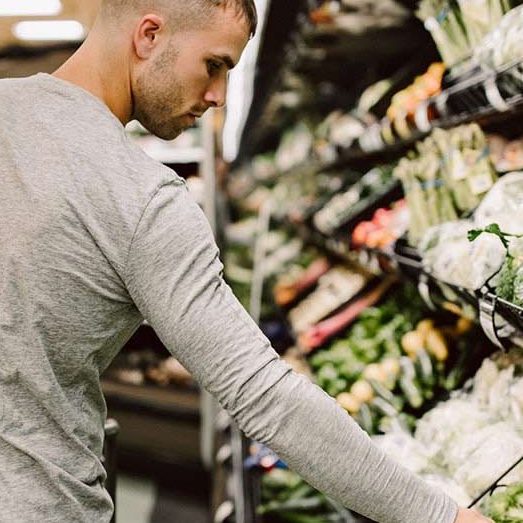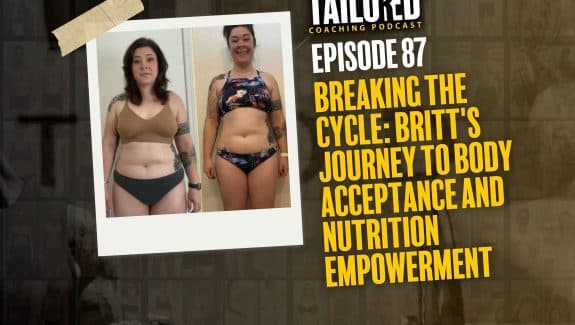When you think about hunger, what comes to mind?
Pain in your abdomen or a growling stomach? Maybe hunger shows up as mental fog and fatigue. To be honest, the sensation of hunger is different for everyone.
Let’s take it a step further. What if I told you that there are different types of hunger? That hunger doesn’t necessarily mean caloric insufficiency.
See, sometimes our drive to consume isn’t about an actual need to consume more calories, or nourishment, or what we call “physiological hunger”.
Instead, sometimes hunger is driven by something called “hedonic hunger” – a desire to experience the pleasure of eating. Everyone can identify hedonic hunger. Think about the last holiday meal you had. You always have room for dessert.
However, the more we understand what drives both types of hunger, the more we can control hunger without manipulating caloric intake. Whether physiological or hedonic hunger is about more than food and more than caloric intake. It’s tied to sleep, stress, food selection, hormones, and so much more. So, when we think about feeling full in a deficit and consuming mostly low calorie foods we need to consider all the drivers that influence hunger.
In this blog we will cover:
- Hormones responsible for hunger and how to regulate them
- Caloric Density versus Food Volume
- Regulating Emotionally Driven Hunger
- Low calorie healthy foods that fill you up
[Before we dive into the article, check out our free ebook – 101-Macro Friendly Meals: Recipe Guide]

Hunger Hormones
Understanding your hunger hormones is essential for understanding how to regulate appetite while eating low calorie foods.
Ghrelin is the hormone that makes us feel hunger. Leptin, on the other hand, tells us that we are satisfied.
Together these hormones influence when you feel the need to eat and when you feel satisfied, and they are affected most by factors other than caloric density. Factors that influence leptin and ghrelin are: sleep, stress, and beliefs about what you eat. We’ll cover each of these.
Sleep, Stress, and Ghrelin
Now, this isn’t directly related to the title of the blog. But, overlooking the key role that sleep and stress have on hunger would be irresponsible, because these factors affect hunger just as much as food selection.
You’ve probably experienced this before: wake up from a rough night of sleep, and feel ravenous all day with cravings raging. This is because sleep deprivation is correlated with increased levels of the appetite stimulating hormone, ghrelin, and suppressed levels of the satiety hormone leptin. One study shows that as little as one night of sleep deprivation is enough to render these responses.
So, the first step to regulating hunger is to regulate sleep. At least 7 hours per night is recommended to regulate your hunger hormones.
Now, the self perpetuating cycle is that lack of sleep can increase stress, while stress can impede sleep.
Regulating sleep is so often easier said than done. Many people turn to sleep aides, or natural remedies, like melatonin, instead of addressing the underlying causes.
Sleep disturbances could be resolved by things as basic as improving your sleep environment. A dark room cooled to 65 degrees is ideal.
Other times, taking a look at your habits with stimulants, like caffeine, is enough to help. For some, simply having a caffeine cut off time is enough to improve sleep. Caffeine has about a 5 hour half-life so it’s recommended to refrain from caffeine intake 5-8 hours before bed time.
Now, as simple and straightforward as those solutions are, the pace, expectations, and connectivity of modern society play a big factor for most people. It’s common to be inside, with little movement, and no exposure to natural light for hours on end, all while being blasted with blue light which dysregulates natural melatonin cycles. Red light therapy, blue light blockers at night, and morning routines can help counter the impact of the modern lifestyle, but still, it often goes deeper than this.
Living in a society so connected through technology makes it almost impossible to “clock out”. The importance of protecting your time and mental space plays a huge role in managing stress levels and improving sleep. Mindfulness practices, nighttime routines, and breathwork are all practices that can help improve this area of your life, and therefore improve sleep, hunger, and satiety responses.
Now, let’s get back to the “meat and potatoes” of this blog.
Beliefs About Your Food
Now, I know this blog is supposed to be about low calorie food that keeps you full, but what if your beliefs about your food mattered more than the actual calories that it contains?
Psychologist Alia Crum conducted a study at Columbia Business School in New York, where she tested how people’s beliefs about food affect their hunger responses.
She had two groups that were given the same milkshake, only one group was told that the shake was zero fat, no added sugar, and only 140 calories. The other group was told that the shake was full fat, full sugar, and 620 calories. The truth is, both shakes were only 300 calories. Ghrelin levels were measured in each group.
Ghrelin levels dropped about three times more in the group of people who just believed they had consumed more, compared to people who believed they had been given a lower calorie drink.
So… the implications from this study are vast. But, believing you will be satisfied with a meal is likely to help you feel that way (this study and the topic of belief, as well as the placebo effect, were discussed in great lengths in this podcast).
Caloric Density Versus Food Volume
Caloric density refers to the number of calories in a certain amount of food. Food volume refers to the amount of food being consumed. Just like calories aren’t the only things that influence hunger, caloric density also isn’t the only thing that determines the volume of food you can eat.
To make this more concrete let’s look at the caloric density of different macros: fat has 9 calories per gram, while carbs and protein only have 4 calories per gram. Fats have double the caloric density of the other macros making them easy to overeat. On top of that, they don’t take up much space in your stomach.
Why does this information matter? When selecting foods, try focusing on simple foods, instead of complex foods with lots of ingredients.
Think about it like a pound of feather versus a pound of bricks: you’ll have way more feathers than bricks in a pound. Instead of bricks and feathers we’re comparing cookies and kale, for example. You’ll get way more kale for 100 calories than you will cookies.
Part of this is because cookies have way more ingredients that bring calorie count up (e.g., butter), but also the type of carbohydrates included in cookies are very calorically dense (e.g., 1 tablespoon of sugar is going to have more calories than 1 tablespoon of kale because there are more carbs crammed into the measurement). So, you have to consider both caloric density and food volume when choosing foods that will fill you up.
The number one way to select foods that will keep you full during a deficit is to focus on nutrient dense, high volume foods. This means, foods that are low calorie, high nutrient, that can bulk up your meals.
Think dark, leafy greens, zucchini, squash – really any vegetable falls into this category, as well as lean meats. These types of foods are good choices not only because they add so much bulk to your meals, but also because they’re packed with fiber and protein.
Meaning, eating 6 ounces of chicken breast will provide more protein, less fat, i.e., less calories, than eating a steak. So, it’s a lower calorie option to get protein up. And, yep, you guessed it, getting protein up will also help with feelings of fullness.
This method allows you to eat a higher volume of food while keeping caloric intake down. The volume helps you feel full, and the diminished caloric intake keeps you in a deficit.
These food choices usually naturally cause you to choose higher fiber food options which may also aide in feelings of fullness. Fiber is a type of carbohydrate that cannot be broken down. It helps regulate blood sugar and is correlated with decreased levels of reported hunger.
Regulating Emotionally Driven Hunger
We have gone over a lot.
Mostly likely, if you have sleep and stress dialed in, and if you are making nutrient-dense food choices, your cravings will likely be minimal.
Highly palatable food makes us want more by dysregulating hunger and satiety cues. Just think about it, if you have a piece of bread with butter, sugar, and cinnamon, you’ll want to eat way more of it than if you were given a plain piece of bread.
Highly-palatable foods are also shown to induce compulsive behavior around food such that you are driven to eat, not because of a need for nutrients or physiological hunger, but a drive more similar to non-drug addiction.
In one study, rats were fed a highly palatable diet rich in sugars and fats. The rats fed a highly palatable diet were more likely to tolerate adverse conditions, including being shocked, in order to continue to eat highly palatable foods. This compulsive behavior implies that the drive to eat, when induced by hedonic hunger, overrides other survival drives, like comfort and safety.
Therefore, the most important takeaway here is that maintaining a balanced, simple, and healthy diet itself will have massive impacts on cravings.
With that said, even when you have life dialed in overwhelm still happens, cravings still can come up. From a mindset perspective it helps to remember that all cravings will pass. Regulating this part of dieting largely comes down to setting realistic expectations before the diet, reframing hunger, and knowing that it will pass.

15 Foods That Fill You Up With Low Calories
- Oatmeal – 121 calories per 30g, high in fiber
- Berries – About 80 calories in 140g. They’re loaded with nutrients, antioxidants, and fiber, helping to curb your sweet tooth and keep you full.
- Popcorn – About 30 calories per cup of air popped, pop corn. Loaded with fiber they’re a great option if you’re craving something salty and snacky.
- Broccoli – 47 calories per 110g, high in grams of fiber
- Cabbage – 16 calories per 100g, high in grams of fiber
- Cauliflower – 34 calories per 100g, high in grams of fiber
- Mushrooms – 14 calories per 100g, high in grams fiber
- Dark Leafy Greens – Such as kale and spinach, help add bulk to meals
- Chicken Breast – 153 calories per 100g, high in grams of protein
- Eggs – About 80 calories egg, Good source of protein, fats, and Vitamin D
- Non-Fat Greek Yogurt – About 130 calories per 150g, good source of protein
- Soup – It can be made with bone broth as a low calorie way to up protein and bulk. Load it with veggies and you’ll have a high volume meal that keeps you full for hours!
- Fish – Lean fish like Cod, Sockeye Salmon, and Tuna boast impressive amounts of nutrients and protein. One study shows that fish had a greater impact on feelings of fullness than chicken.
- Potatoes – If you stay away from fried potatoes and loading them up with a bunch of additional ingredients, potatoes are a solid way to add bulk and fiber to a meal to keep you fuller, longer.
- Watermelon – 40 calories in 150g. Loaded with micronutrients, and water, watermelon is a great option to help you feel full.
It’s important to note that eating any of these foods to the point that you are no longer in a caloric deficit will interrupt weight loss. But, since these foods are high in fiber and protein, they can help you stay full, while making it easy to stay in a deficit.
A personal favorite for me, is to take all the above veggies, roast or sauté them, add my favorite lean protein (for me, that’s Chicken Breast or Sockeye Salmon), and throw some potatoes on the side for a healthy, filling protein bowl that keeps me fueled, full, and on track.
If you want to decrease calorie intake, lose weight, and feel fuller in the process, consider these options to meet your dietary needs.























































































































































































































































































































































































































































































